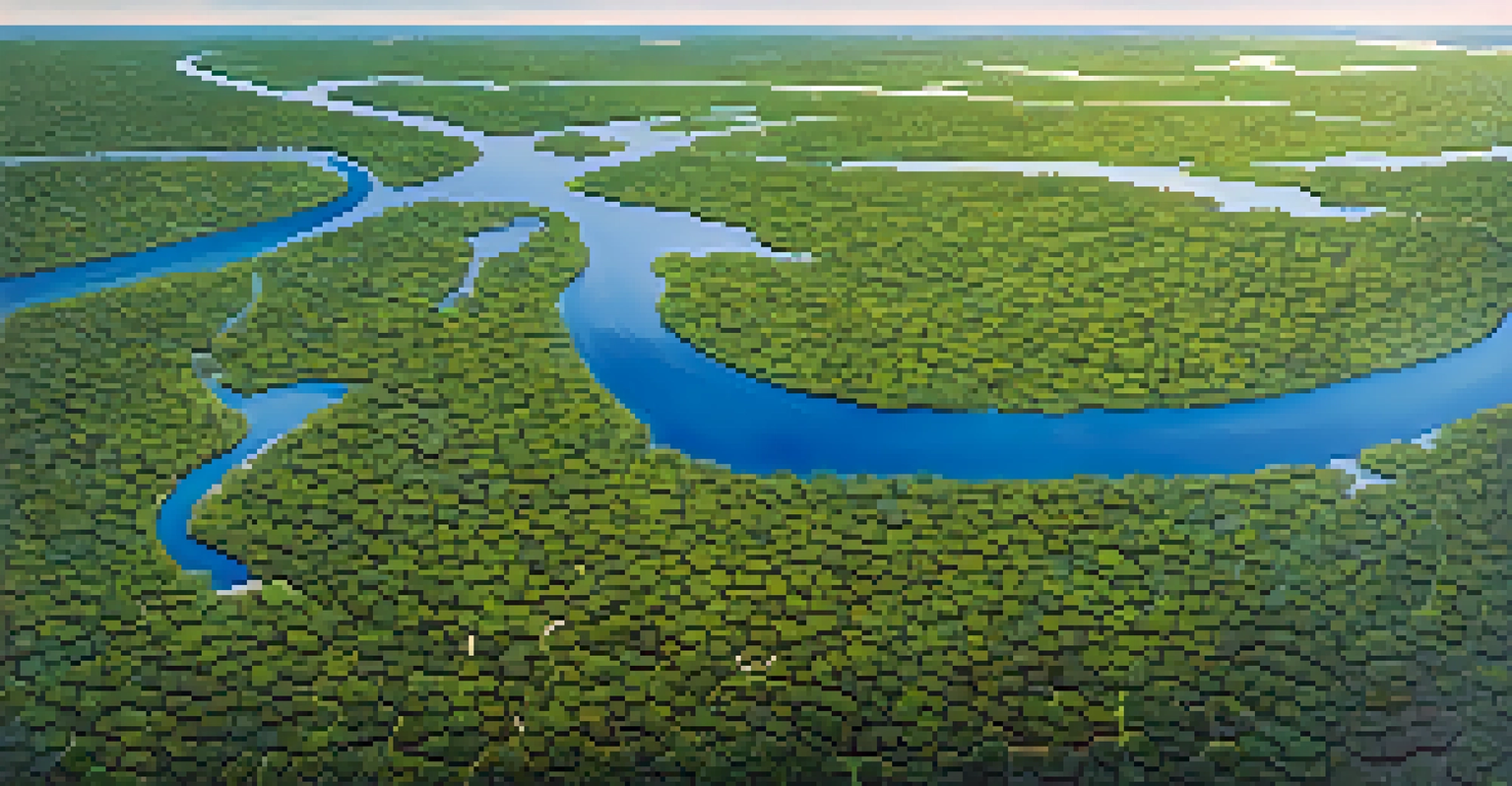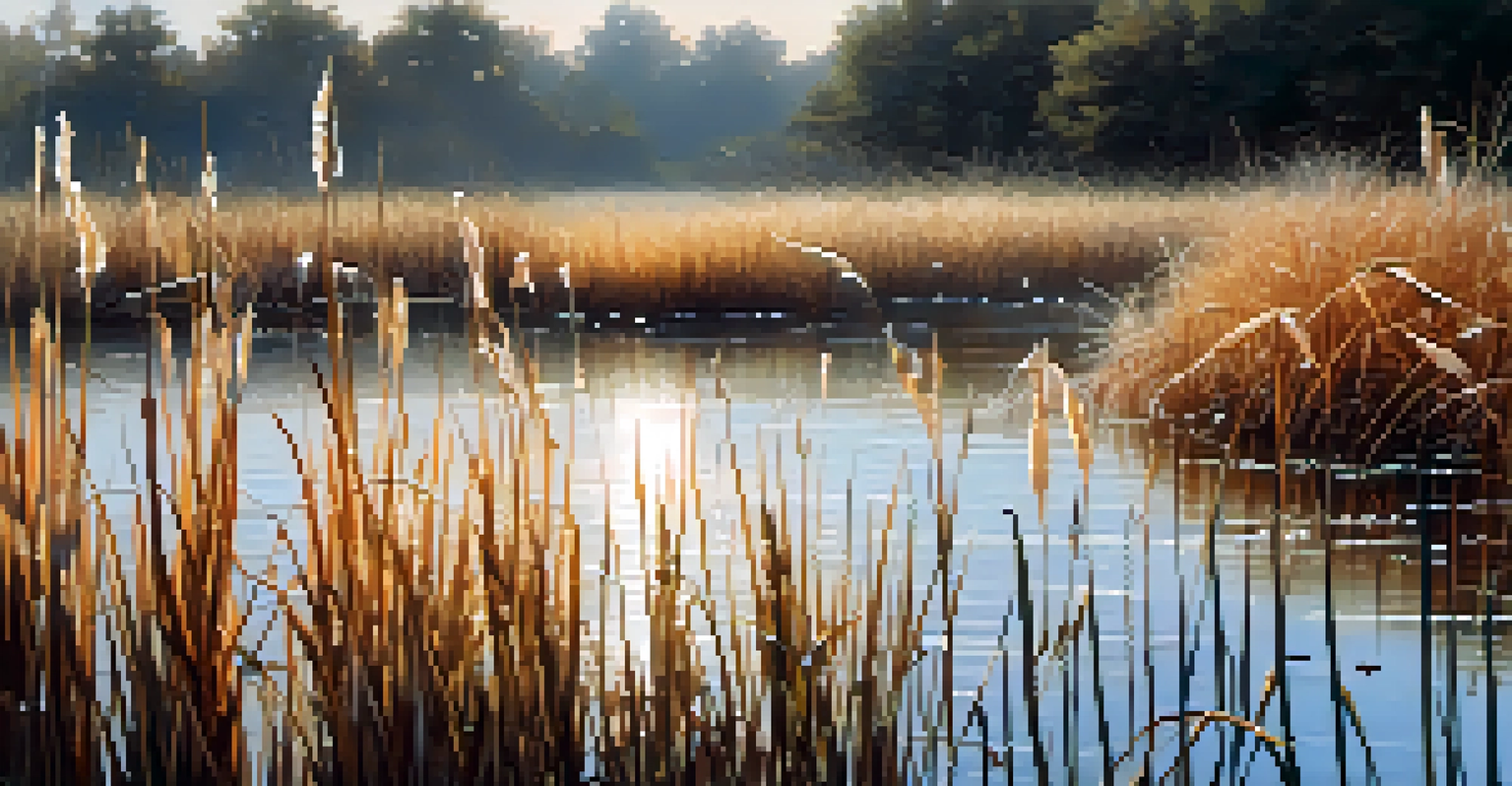The Importance of Wetlands in Florida's Climate Resilience

What Are Wetlands and Why Do They Matter?
Wetlands are unique ecosystems where water covers the soil, either permanently or seasonally. They include swamps, marshes, and bogs, and they play a crucial role in Florida's environment. By acting as natural water filters, wetlands improve water quality and provide habitats for diverse wildlife.
Wetlands are among the most productive ecosystems in the world, providing vital services that benefit both people and wildlife.
In Florida, wetlands are particularly vital due to the state's geography, which is heavily influenced by water. These ecosystems not only support a rich variety of plant and animal species, but they also help mitigate flooding by absorbing excess rainwater. This is especially important in a state prone to hurricanes and heavy rainfall.
Moreover, wetlands serve as carbon sinks, meaning they store carbon dioxide from the atmosphere. This characteristic is essential for combating climate change, as it helps reduce greenhouse gases and their harmful effects. So, understanding wetlands' functions is key to appreciating their importance in climate resilience.
Wetlands as Natural Flood Buffers
One of the standout features of wetlands is their ability to absorb and store water. This capacity makes them natural flood buffers, which is crucial for Florida, especially during hurricane season. When heavy rains hit, wetlands can help prevent flooding in nearby communities by soaking up excess water.

For example, the Everglades, a vast wetland system in Florida, plays a significant role in managing water levels across the region. When the waters rise, the Everglades act like a sponge, absorbing the surplus and releasing it gradually. This slow release helps maintain the balance in local ecosystems and protects urban areas from sudden floods.
Wetlands Improve Water Quality
Wetlands act as natural water filters, trapping pollutants and enhancing the health of Florida's water sources.
In addition to protecting homes and businesses, this flood mitigation also safeguards agricultural lands. By preventing excessive flooding, wetlands ensure that crops remain healthy and productive, supporting Florida's economy. Protecting and restoring these wetland areas is thus essential for both ecological health and economic stability.
The Role of Wetlands in Water Quality Improvement
Wetlands act as nature's water treatment plants, filtering pollutants and improving water quality. As water flows through these ecosystems, sediments and toxins are trapped in the vegetation and soil, allowing cleaner water to flow into rivers, lakes, and oceans. This process is vital for maintaining the health of Florida's diverse aquatic habitats.
The health of our wetlands is crucial for the health of our planet.
For instance, without wetlands, harmful nutrients like nitrogen and phosphorus from agricultural runoff could contaminate freshwater sources. This contamination can lead to algal blooms, which are detrimental to fish populations and overall water quality. Wetlands help to reduce these risks by absorbing and breaking down these pollutants naturally.
Moreover, clean water is essential for human communities as well. Many Floridians rely on local water sources for drinking, recreation, and tourism. Protecting wetlands not only enhances ecological health but also secures clean water for residents, thereby reinforcing the connection between wetland protection and community well-being.
Biodiversity and Habitat Preservation in Wetlands
Wetlands are biodiversity hotspots, providing crucial habitats for countless species. In Florida, these ecosystems support a wide range of wildlife, including endangered species like the Florida panther and the American crocodile. The variety of plant and animal life found in wetlands contributes to the overall health of the ecosystem.
By preserving wetland habitats, we ensure that these species have the resources they need to thrive. For example, migratory birds rely on wetlands as stopover points during their long journeys. Protecting these areas means providing essential food and resting places for these birds, which helps maintain Florida's rich avian diversity.
Natural Flood Mitigation
Wetlands absorb excess rainwater, serving as crucial buffers against flooding, particularly during hurricane season.
Furthermore, wetlands contribute to the resilience of entire ecosystems. Healthy wetlands can recover more quickly from disturbances like storms or droughts, making them vital for maintaining ecological balance. By safeguarding wetland areas, we support not just individual species but the intricate web of life that depends on them.
Climate Change and Wetlands: A Vulnerable Relationship
As climate change progresses, wetlands face significant threats from rising sea levels and changing weather patterns. Florida's coastal wetlands are particularly at risk, as saltwater intrusion can alter the delicate balance of these ecosystems. This shift can lead to habitat loss and decreased biodiversity.
Moreover, extreme weather events, such as hurricanes and heavy rainfall, can disrupt wetland functions, affecting their ability to filter water and mitigate floods. As these ecosystems become more vulnerable, the impacts are felt across the region, highlighting the urgent need for conservation efforts.
Addressing these challenges requires a multifaceted approach, including restoration projects and sustainable land use practices. By actively working to protect and restore wetlands, we not only safeguard these vital ecosystems but also enhance Florida's overall climate resilience.
Community Engagement in Wetland Conservation
Community involvement is crucial for the successful conservation of wetlands. Local groups and organizations play a significant role in raising awareness about the importance of these ecosystems and advocating for their protection. When communities come together, they can create impactful conservation initiatives that benefit both the environment and local residents.
For example, educational programs can teach residents about the value of wetlands and how to protect them. Workshops, cleanup events, and citizen science projects can empower people to take action, fostering a sense of stewardship toward these important habitats. Engaging the community encourages a collective responsibility for protecting Florida's natural resources.
Biodiversity Hotspots
Wetlands provide essential habitats for diverse wildlife, supporting endangered species and maintaining ecological balance.
Additionally, involving local voices in conservation efforts ensures that the unique needs and concerns of each community are addressed. By creating partnerships between governments, nonprofits, and community members, we can develop tailored strategies that effectively protect wetlands while also benefiting local economies and ecosystems.
Strategies for Protecting Florida's Wetlands
To protect Florida's wetlands effectively, a combination of strategies is necessary. Restoration projects can help revive degraded wetlands, while sustainable land use practices can minimize further damage. For example, implementing buffer zones around wetland areas can reduce pollution from nearby agricultural and urban developments.
Legislation also plays a key role in wetland protection. Policies that regulate development in wetland areas, along with initiatives that promote conservation funding, can create a more sustainable future for these ecosystems. Advocacy for stronger environmental laws can ensure that wetlands are prioritized in planning and development processes.

Finally, collaboration among stakeholders, including government agencies, private landowners, and conservation organizations, is essential. By working together, we can share resources and knowledge, enhancing the effectiveness of conservation efforts. This collective approach is vital for ensuring that Florida's wetlands continue to thrive in the face of climate change and development pressures.